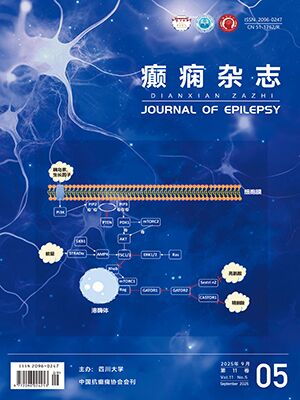| 1. |
Osborne JP, Fryer A, Webb D. Epidemiology of tuberous sclerosis. Ann Ny Acad Sci, 1991, 61(21):125-127.
|
| 2. |
Curatolo P, Bombardieri R, Jozwiak S. Tuberous sclerosis. Lancet, 2008, 372(9639):657-668.
|
| 3. |
Wang S, Fallah A. Optimal management of seizures associated with tuberous sclerosis complex:current and emerging options. Neuropsychiatr Dis Treat, 2014, 10(8):2021-2030.
|
| 4. |
Thiele EA. Managing and understanding epilepsy in tuberous sclerosis complex. Epilepsia, 2010, 51(Suppl 1):90-91.
|
| 5. |
Angehagen M, Ben-Menachem E, Ronnback L, et al. Novel mechanisms of action of three antiepileptic drugs, vigabatrin, tiagabine, and topiramate. Neurochem Res, 2003, 28(2):333-340.
|
| 6. |
Shields WD, Pellock JM. Vigabatrin 35 years later-from mechanism of action to benefit-risk considerations. Acta Neurol Scand, 2011, 192(Suppl 2):1-4.
|
| 7. |
Aicardi J, Mumford JP, Dumas C, et al. Vigabatrin as initial therapy for infantile spasms:a European retrospective survey. Sabril IS Investigator and Peer Review Groups. Epilepsia, 1996, 37(7):638-642.
|
| 8. |
Schwarz MD, Li M, Tsao J, et al. A lack of clinically apparent vision loss among patients treated with vigabatrin with infantile spasms:The UCLA experience. Epilepsy Behav, 2016, 57(Pt A):29-33.
|
| 9. |
Nabbout RC, Chiron C, Mumford J, et al. Vigabatrin in partial seizures in children. J Child Neurol, 1997, 12(3):172-177.
|
| 10. |
Willmore LJ, Abelson MB, Ben-Menachem E, et al. Vigabatrin:2008 update. Epilepsia, 2009, 50(2):163-173.
|
| 11. |
Riikonen RS. Favourable prognostic factors with infantile spasms. Eur J Paediatr Neurol, 2010, 14(1):13-18.
|
| 12. |
Hancock E, Osborne J, Milner P. Treatment of infantile spasms. Cochrane Database Syst Rev, 2003, (3):Cd001770.
|
| 13. |
Chiron C, Dumas C, Jambaque I, et al. Randomized trial comparing vigabatrin and hydrocortisone in infantile spasms due to tuberous sclerosis. Epilepsy Res, 1997, 26(2):389-395.
|
| 14. |
Yum MS, Lee EH, Ko TS. Vigabatrin and mental retardation in tuberous sclerosis:infantile spasms versus focal seizures. J Child Neurol, 2013, 28(3):308-313.
|
| 15. |
Appleton RE. The role of vigabatrin in the management of infantile epileptic syndromes. Neurology, 1993, 43(11 Suppl 5):21-23.
|
| 16. |
Elterman RD, Shields WD, Bittman RM, et al. Vigabatrin for the treatment of infantile spasms:final report of a randomized trial. J Child Neurol, 2010, 25(11):1340-1347.
|
| 17. |
Gaily E, Jonsson H, Lappi M. Visual fields at school-age in children treated with vigabatrin in infancy. Epilepsia, 2009, 50(2):206-216.
|
| 18. |
Taghdiri MM, Ashrafi MR, Bakhshandeh-Bali MK, et al. Clinical trial of vigabatrin as adjunctive therapy in children with refractory epilepsy. Iran J Pediatr, 2013, 23(6):653-658.
|
| 19. |
Friedman D, Bogner M, Parker-Menzer K, et al. Vigabatrin for partial-onset seizure treatment in patients with tuberous sclerosis complex. Epilepsy Behav, 2013, 27(1):118-120.
|




